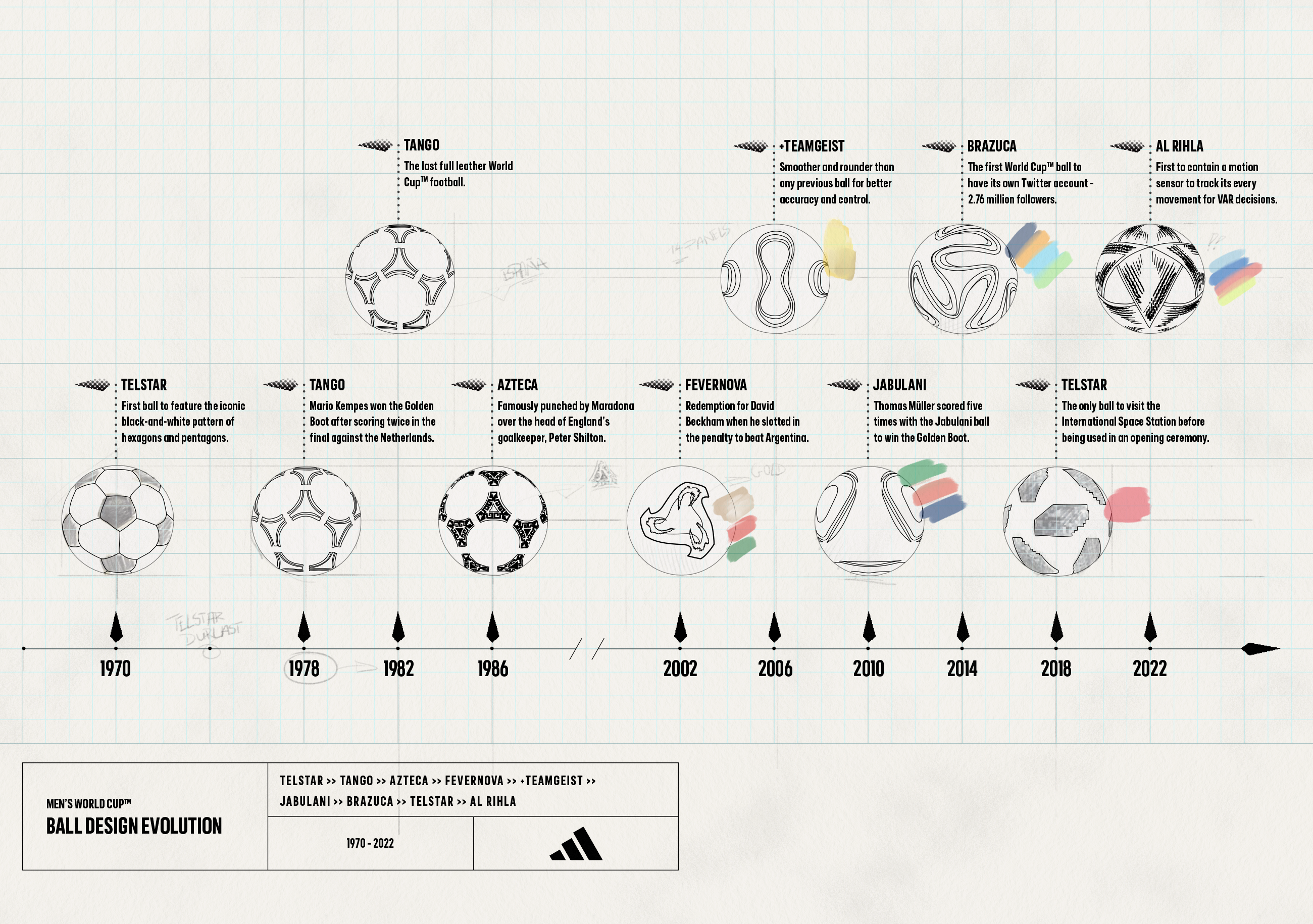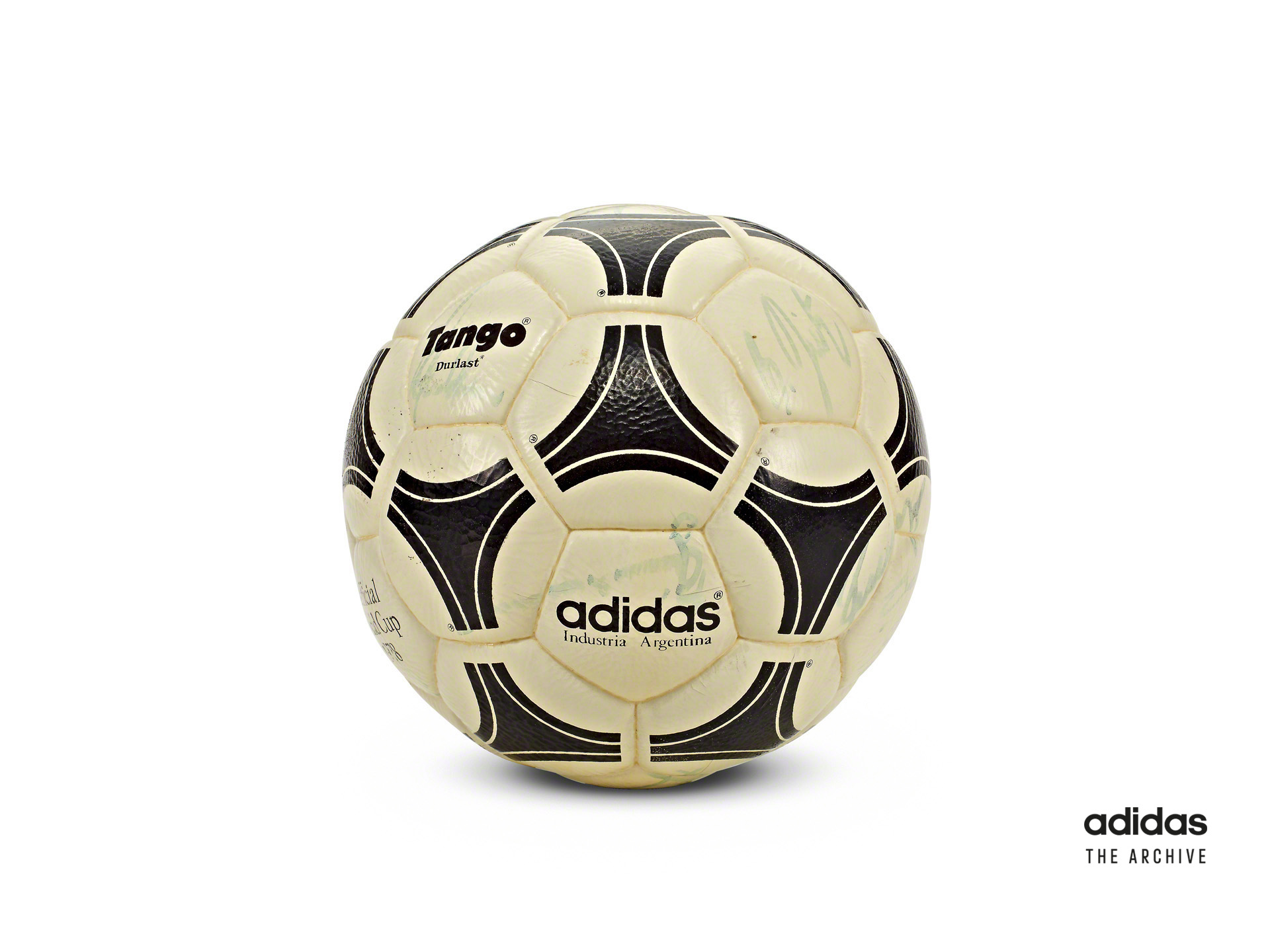adidas Official Match Ball for World Cup™ Through The Years
Imagine the difference between booting the heavy-laced leather balls in the 1930s to playing with 2022’s revolutionary new FIFA World Cup™ ball. The development of materials and technology has changed the game. The skillset, speed and excitement of football has been influenced by the evolution of the ball. Not just in the FIFA World Cup™, but through the whole game of football too.
Which Ball Will Be Used In The 2022 FIFA World Cup™?
The FIFA World Cup™ 2022 ball will be the 14th in a row designed by adidas. Named the Al Rihla (‘The Journey’ in Arabic) it shows just how far footballs have come over the last 90 years. The Al Rihla is faster in flight than any other FIFA World Cup™ ball, and more sustainable than the previous balls.
It’s also the first ever FIFA World Cup™ ball to use connected ball technology. This involves a motion sensor inside the ball tracking its every movement. This data is sent to the Video Assistant Referee (VAR) and helps with decisions such as ruling when a player is offside.
Al Rihla is the first World Cup ball in the 92-year history of the tournament which will directly contribute to raising funds to positively impact lives across the world.
“We are also proud to continue our work with Common Goal, with 1% of Al Rihla’s net sales supporting the movement, together using football as a vehicle to drive social change and meaningful impact for the lives of young people”, said Nick Craggs, General Manager – Football, adidas.
Where Is The Fifa 2022 FIFA World Cup™ Ball Made?
Pakistan’s ball-making expertise is long-held and beyond doubt. The balls will be made there for the third tournament in a row.
Each FIFA World Cup™ game features a unique set of balls, which are personalised with the teams involved, the date and the venue. These soon become collectors’ pieces and those not given away to match officials or hat-trick scorers are often offered as prizes to be won by lucky fans. So keep your eyes peeled for competitions after Qatar.
The History Of Adidas FIFA World Cup™ Balls
Between the first official tournament in 1930 and the London event in 1966, the match balls were nothing like those you see today. They were stitched together from heavy brown leather. The colour changed when television broadcasts became widespread, and brown balls were hard to pick out on black and white TV.
The first ever final, between Uruguay and Argentina, was unusual in that the game featured two types of balls. The teams couldn’t decide which one to use so in the first half they played with the Tiento, a ball chosen by Argentina. In the second half, they played with the heavier T-Model, chosen by Uruguay who went on to win.
First asked to provide the balls in 1970, adidas has since produced them for every FIFA World Cup™. Here’s a selection that broke the mould for one reason or another.

2018 Telstar
The first official match ball developed by adidas for the 1970 finals, the Telstar reappeared for the 2018 FIFA World Cup™ for France’s victory against Croatia. The 2018 ball recalled the FIFA World Cup™ ball’s iconic black and white pattern of hexagons and pentagons, updated with a pixelated design. When we asked people to draw a football as part of some research, 99% of them drew a ball that resembles the Telstar.
2014 Brazuca
The 2014 FIFA World Cup™ ball was the first to have its own Twitter account. This social media savvy football had a top score of 2.76 million followers. It was the year that saw the first European team win the competition in the Americas. Germany scored the only goal against Argentina in the final in Rio de Janeiro.
The Brazuca ball was tested by over 600 professional players in 10 countries spanning three continents before it was first kicked in competition – more than any other ball adidas has ever developed.
2010 Jabulani
Perhaps the most well-known of FIFA World Cup™ footballs is from the 2010 competition – the Jabulani ball. Eight thermally bonded panels (reduced from 14 in the previous FIFA World Cup™ ball), made it the roundest ever.
The name means ‘to celebrate’ in isiZulu. Thomas Müller certainly celebrated after netting the Jabulani ball five times throughout the tournament and was awarded the Golden Boot for his efforts.
During the final, the Jabulani met its match. Spain’s goalkeeper and captain Iker Casillas made two expert stops against the Netherlands’ Arjen Robben. Casillas was awarded the Golden Glove and Spain were FIFA World Cup™ winners.
2006 +Teamgeist
The +Teamgeist – the 2006 FIFA World Cup™ ball – transformed footballs. Its 14 panels (instead of the usual 32) were thermally bonded instead of stitched together. The ball was designed to have a spectacular action and to encourage strikers to shoot from anywhere. 2006 was the year that started the trend of using a special version of the FIFA World Cup™ ball for the final.
The +Teamgeist was under the spotlight during the iconic, action-packed match between France and Italy. Its cutting-edge precision and trajectory were evident as Italy’s Fabio Grosso calmly netted the winning penalty against France in a dramatic end to the tournament."
2002 Fevernova
Specially created for the 2002 FIFA World Cup™, the Fevernova marked a radical change from the traditional black and white design. On the outside, it had a colourful pattern influenced by Asian culture. On the inside, it had a special foam layer that gave it a more predictable flight path. It resulted in some spectacular goals, such as Ronaldo slotting the ball past Germany’s Oliver Kahn to cement Brazil’s victory in the final.
1986 Azteca
The Azteca, the FIFA World Cup™ ball used in 1986, was the accomplice in a famous ‘sleight of hand’. It was punched over the head of England’s goalkeeper, Peter Shilton, by Argentina’s Maradona in the famous ‘Hand of God’ incident. Not that it made much difference as Maradona went on to score an amazing individual goal later in the match.
1978 and 1982 Tango
Used in the 1978 and 1982 FIFA World Cup™ competitions, the Tango design was created from 20 hand-stitched panels coated in a thin membrane to stop waterlogging. Instantly recognisable, its triangular marking created the illusion of white circles on the surface, which helped players track the spin of the ball.
A FIFA World Cup™ ball for two tournaments that left strong legacies. In particular, the 1982 competition saw Italy break from their 44 years of no victories, going on to win the trophy against West Germany.

Not Long Now To See The Al Rihla In Action
As 20 November draws nearer, the excitement is starting to build. Many questions will be answered by the time the final whistle blows on 18 December. Which team will raise the famous trophy? Who will win the Golden Boot? And, of course, what part will the revolutionary Al Rihla ball play in creating football history? The wait is almost over.
And while you’re waiting for the drama to unfold, why not find out more about our FIFA World Cup™ boots and read our Quick Guide to the FIFA World Cup™? Then, just like the players themselves, you’ll be fully prepared for when the action begins.
